Liam's Case Study: Lifespan, Determinants, and Interventions
VerifiedAdded on 2021/06/17
|15
|3551
|122
Case Study
AI Summary
This case study examines Liam, a child facing challenges related to obesity, stress, and social interactions, using the bio-psycho-social model of care. It analyzes Liam's lifespan development, focusing on Erikson's stages, and identifies biological (obesity), social (socioeconomic status, bullying), and psychological determinants contributing to his difficulties. The study explores Liam's stress management, emotional well-being, and the impact of these factors on his behavior and mental health. The assignment suggests family-centered therapy and other interventions to promote Liam's mental and physical health, emphasizing the importance of addressing both internal and external factors to improve his quality of life. The study underscores the need for healthcare professionals to consider a holistic approach when assessing and treating children's health issues.
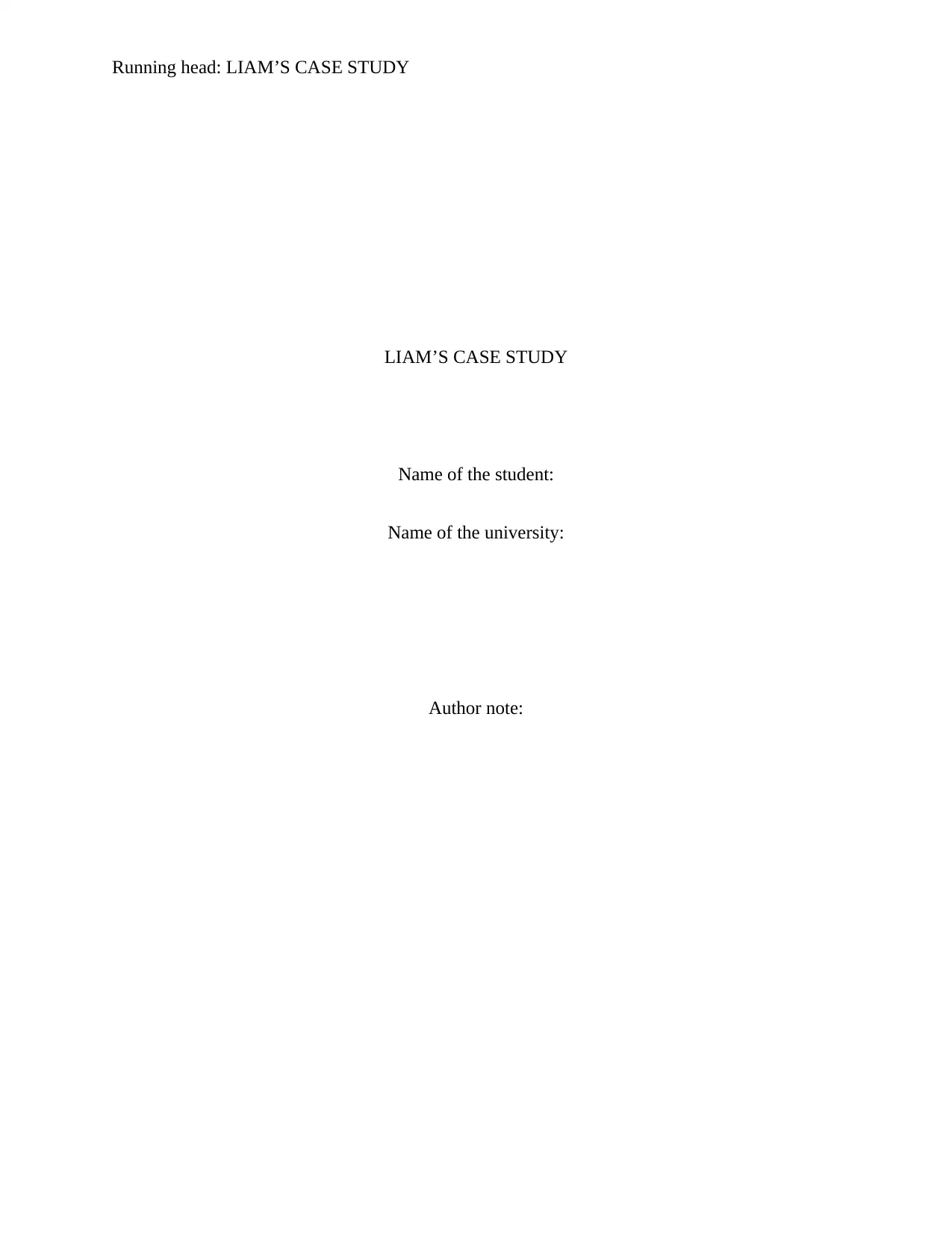
Running head: LIAM’S CASE STUDY
LIAM’S CASE STUDY
Name of the student:
Name of the university:
Author note:
LIAM’S CASE STUDY
Name of the student:
Name of the university:
Author note:
Paraphrase This Document
Need a fresh take? Get an instant paraphrase of this document with our AI Paraphraser
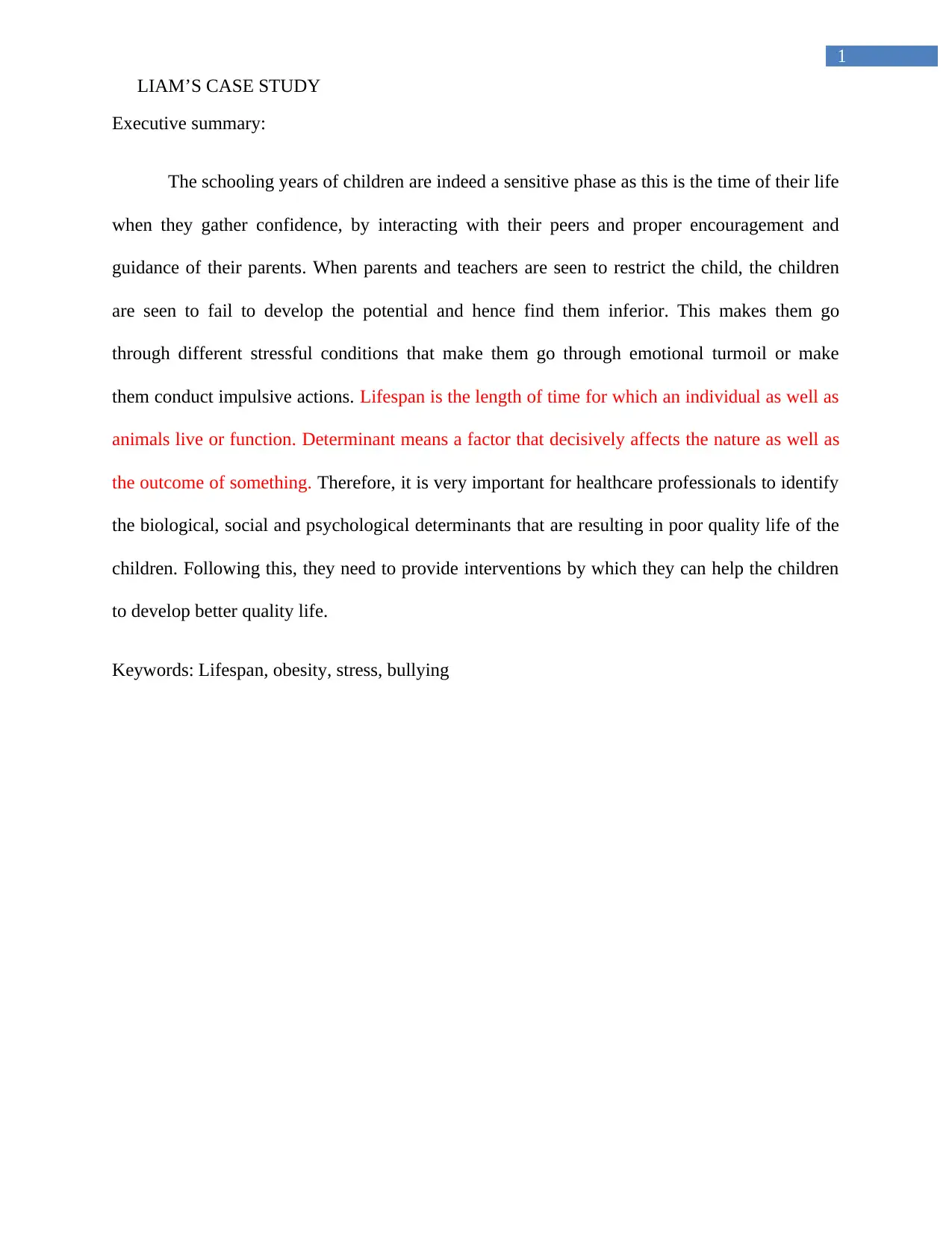
1
LIAM’S CASE STUDY
Executive summary:
The schooling years of children are indeed a sensitive phase as this is the time of their life
when they gather confidence, by interacting with their peers and proper encouragement and
guidance of their parents. When parents and teachers are seen to restrict the child, the children
are seen to fail to develop the potential and hence find them inferior. This makes them go
through different stressful conditions that make them go through emotional turmoil or make
them conduct impulsive actions. Lifespan is the length of time for which an individual as well as
animals live or function. Determinant means a factor that decisively affects the nature as well as
the outcome of something. Therefore, it is very important for healthcare professionals to identify
the biological, social and psychological determinants that are resulting in poor quality life of the
children. Following this, they need to provide interventions by which they can help the children
to develop better quality life.
Keywords: Lifespan, obesity, stress, bullying
LIAM’S CASE STUDY
Executive summary:
The schooling years of children are indeed a sensitive phase as this is the time of their life
when they gather confidence, by interacting with their peers and proper encouragement and
guidance of their parents. When parents and teachers are seen to restrict the child, the children
are seen to fail to develop the potential and hence find them inferior. This makes them go
through different stressful conditions that make them go through emotional turmoil or make
them conduct impulsive actions. Lifespan is the length of time for which an individual as well as
animals live or function. Determinant means a factor that decisively affects the nature as well as
the outcome of something. Therefore, it is very important for healthcare professionals to identify
the biological, social and psychological determinants that are resulting in poor quality life of the
children. Following this, they need to provide interventions by which they can help the children
to develop better quality life.
Keywords: Lifespan, obesity, stress, bullying
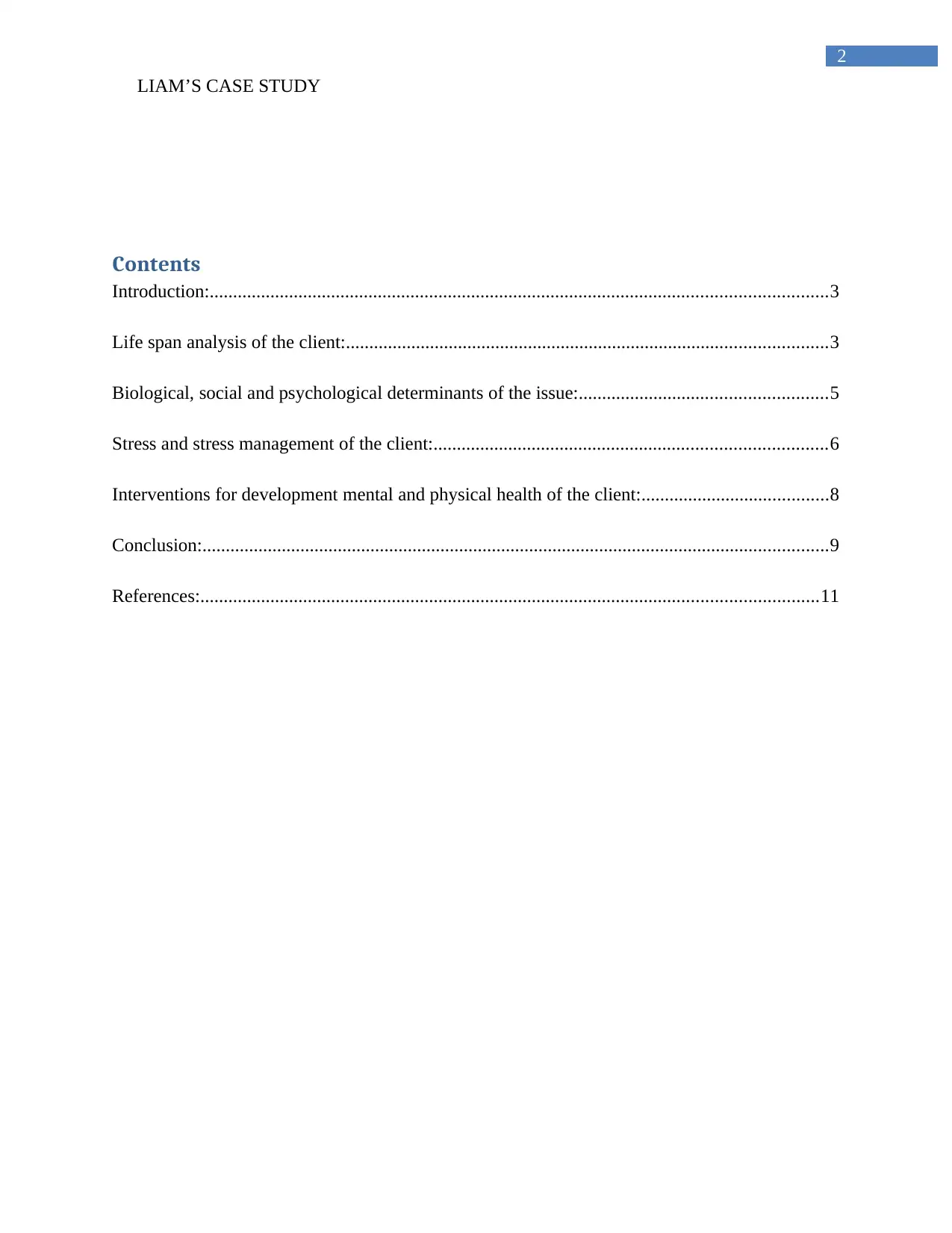
2
LIAM’S CASE STUDY
Contents
Introduction:....................................................................................................................................3
Life span analysis of the client:.......................................................................................................3
Biological, social and psychological determinants of the issue:.....................................................5
Stress and stress management of the client:....................................................................................6
Interventions for development mental and physical health of the client:........................................8
Conclusion:......................................................................................................................................9
References:....................................................................................................................................11
LIAM’S CASE STUDY
Contents
Introduction:....................................................................................................................................3
Life span analysis of the client:.......................................................................................................3
Biological, social and psychological determinants of the issue:.....................................................5
Stress and stress management of the client:....................................................................................6
Interventions for development mental and physical health of the client:........................................8
Conclusion:......................................................................................................................................9
References:....................................................................................................................................11
⊘ This is a preview!⊘
Do you want full access?
Subscribe today to unlock all pages.

Trusted by 1+ million students worldwide
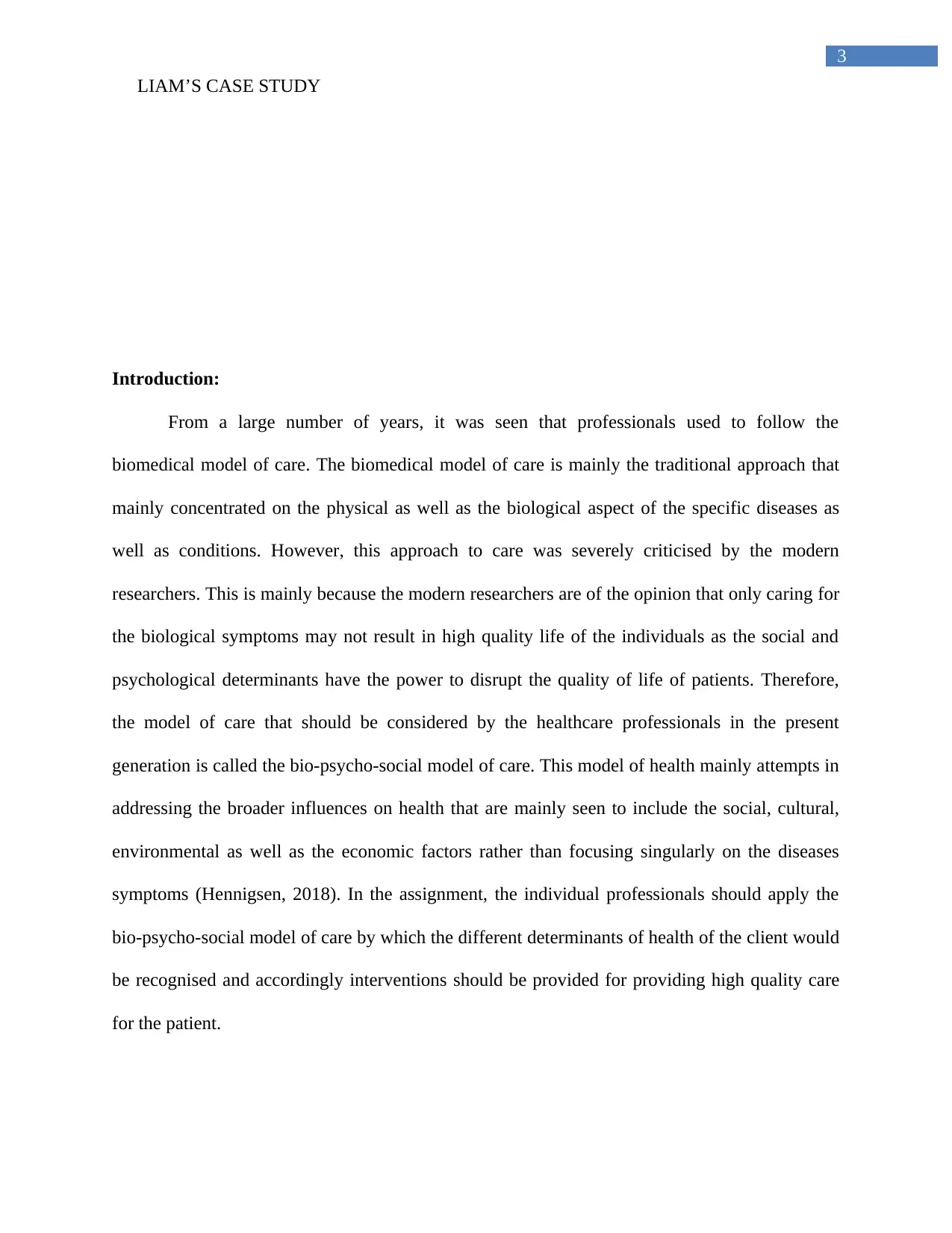
3
LIAM’S CASE STUDY
Introduction:
From a large number of years, it was seen that professionals used to follow the
biomedical model of care. The biomedical model of care is mainly the traditional approach that
mainly concentrated on the physical as well as the biological aspect of the specific diseases as
well as conditions. However, this approach to care was severely criticised by the modern
researchers. This is mainly because the modern researchers are of the opinion that only caring for
the biological symptoms may not result in high quality life of the individuals as the social and
psychological determinants have the power to disrupt the quality of life of patients. Therefore,
the model of care that should be considered by the healthcare professionals in the present
generation is called the bio-psycho-social model of care. This model of health mainly attempts in
addressing the broader influences on health that are mainly seen to include the social, cultural,
environmental as well as the economic factors rather than focusing singularly on the diseases
symptoms (Hennigsen, 2018). In the assignment, the individual professionals should apply the
bio-psycho-social model of care by which the different determinants of health of the client would
be recognised and accordingly interventions should be provided for providing high quality care
for the patient.
LIAM’S CASE STUDY
Introduction:
From a large number of years, it was seen that professionals used to follow the
biomedical model of care. The biomedical model of care is mainly the traditional approach that
mainly concentrated on the physical as well as the biological aspect of the specific diseases as
well as conditions. However, this approach to care was severely criticised by the modern
researchers. This is mainly because the modern researchers are of the opinion that only caring for
the biological symptoms may not result in high quality life of the individuals as the social and
psychological determinants have the power to disrupt the quality of life of patients. Therefore,
the model of care that should be considered by the healthcare professionals in the present
generation is called the bio-psycho-social model of care. This model of health mainly attempts in
addressing the broader influences on health that are mainly seen to include the social, cultural,
environmental as well as the economic factors rather than focusing singularly on the diseases
symptoms (Hennigsen, 2018). In the assignment, the individual professionals should apply the
bio-psycho-social model of care by which the different determinants of health of the client would
be recognised and accordingly interventions should be provided for providing high quality care
for the patient.
Paraphrase This Document
Need a fresh take? Get an instant paraphrase of this document with our AI Paraphraser
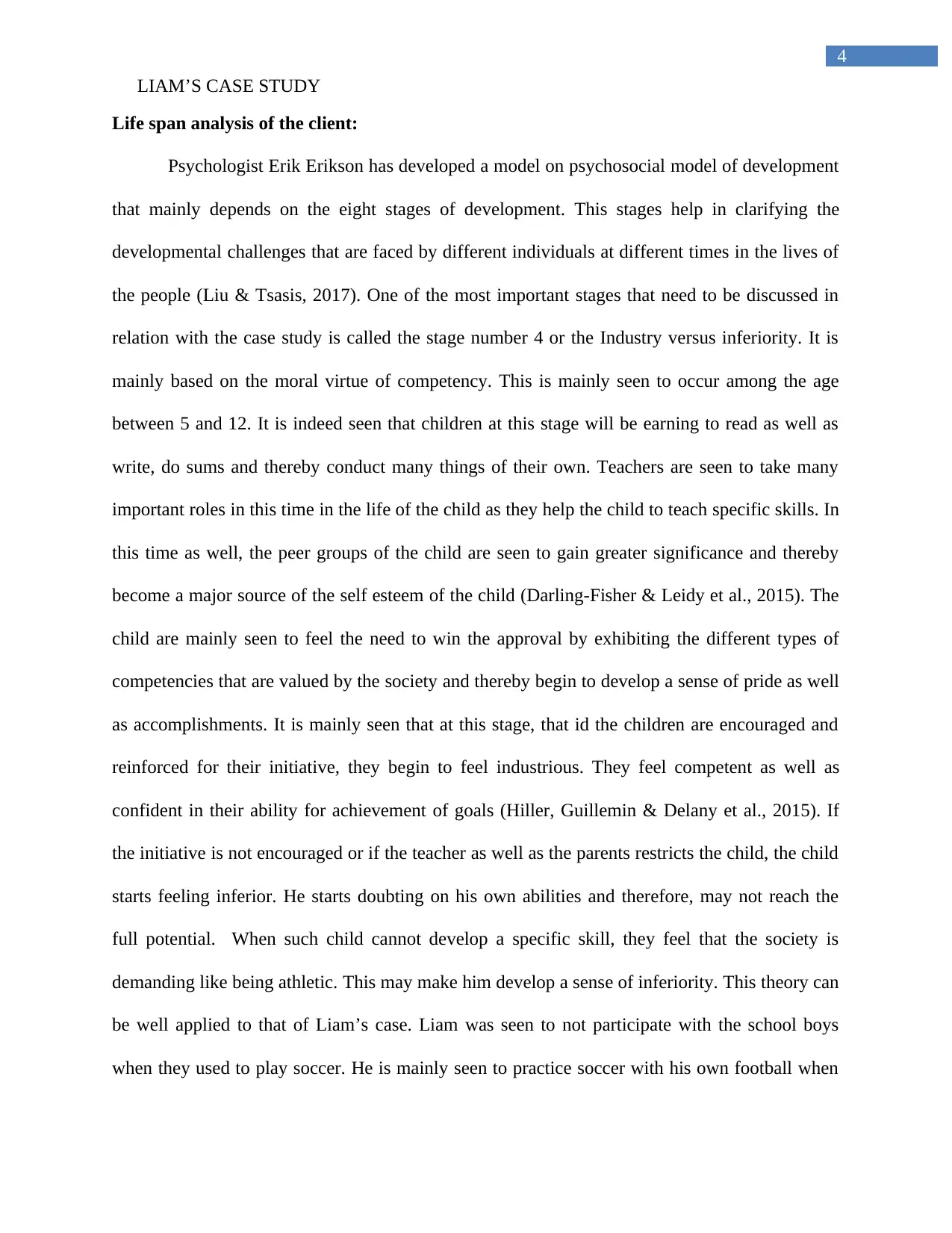
4
LIAM’S CASE STUDY
Life span analysis of the client:
Psychologist Erik Erikson has developed a model on psychosocial model of development
that mainly depends on the eight stages of development. This stages help in clarifying the
developmental challenges that are faced by different individuals at different times in the lives of
the people (Liu & Tsasis, 2017). One of the most important stages that need to be discussed in
relation with the case study is called the stage number 4 or the Industry versus inferiority. It is
mainly based on the moral virtue of competency. This is mainly seen to occur among the age
between 5 and 12. It is indeed seen that children at this stage will be earning to read as well as
write, do sums and thereby conduct many things of their own. Teachers are seen to take many
important roles in this time in the life of the child as they help the child to teach specific skills. In
this time as well, the peer groups of the child are seen to gain greater significance and thereby
become a major source of the self esteem of the child (Darling-Fisher & Leidy et al., 2015). The
child are mainly seen to feel the need to win the approval by exhibiting the different types of
competencies that are valued by the society and thereby begin to develop a sense of pride as well
as accomplishments. It is mainly seen that at this stage, that id the children are encouraged and
reinforced for their initiative, they begin to feel industrious. They feel competent as well as
confident in their ability for achievement of goals (Hiller, Guillemin & Delany et al., 2015). If
the initiative is not encouraged or if the teacher as well as the parents restricts the child, the child
starts feeling inferior. He starts doubting on his own abilities and therefore, may not reach the
full potential. When such child cannot develop a specific skill, they feel that the society is
demanding like being athletic. This may make him develop a sense of inferiority. This theory can
be well applied to that of Liam’s case. Liam was seen to not participate with the school boys
when they used to play soccer. He is mainly seen to practice soccer with his own football when
LIAM’S CASE STUDY
Life span analysis of the client:
Psychologist Erik Erikson has developed a model on psychosocial model of development
that mainly depends on the eight stages of development. This stages help in clarifying the
developmental challenges that are faced by different individuals at different times in the lives of
the people (Liu & Tsasis, 2017). One of the most important stages that need to be discussed in
relation with the case study is called the stage number 4 or the Industry versus inferiority. It is
mainly based on the moral virtue of competency. This is mainly seen to occur among the age
between 5 and 12. It is indeed seen that children at this stage will be earning to read as well as
write, do sums and thereby conduct many things of their own. Teachers are seen to take many
important roles in this time in the life of the child as they help the child to teach specific skills. In
this time as well, the peer groups of the child are seen to gain greater significance and thereby
become a major source of the self esteem of the child (Darling-Fisher & Leidy et al., 2015). The
child are mainly seen to feel the need to win the approval by exhibiting the different types of
competencies that are valued by the society and thereby begin to develop a sense of pride as well
as accomplishments. It is mainly seen that at this stage, that id the children are encouraged and
reinforced for their initiative, they begin to feel industrious. They feel competent as well as
confident in their ability for achievement of goals (Hiller, Guillemin & Delany et al., 2015). If
the initiative is not encouraged or if the teacher as well as the parents restricts the child, the child
starts feeling inferior. He starts doubting on his own abilities and therefore, may not reach the
full potential. When such child cannot develop a specific skill, they feel that the society is
demanding like being athletic. This may make him develop a sense of inferiority. This theory can
be well applied to that of Liam’s case. Liam was seen to not participate with the school boys
when they used to play soccer. He is mainly seen to practice soccer with his own football when
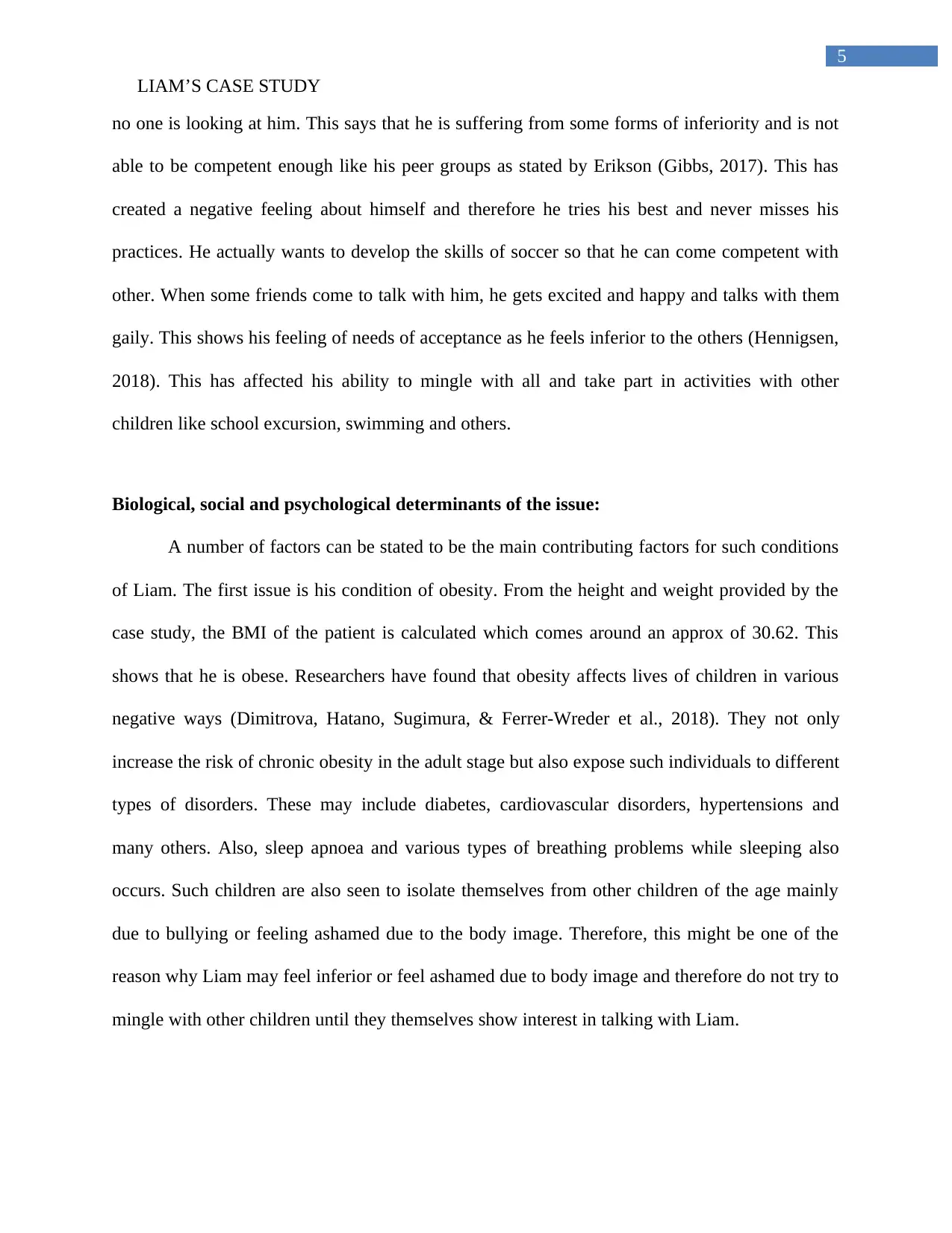
5
LIAM’S CASE STUDY
no one is looking at him. This says that he is suffering from some forms of inferiority and is not
able to be competent enough like his peer groups as stated by Erikson (Gibbs, 2017). This has
created a negative feeling about himself and therefore he tries his best and never misses his
practices. He actually wants to develop the skills of soccer so that he can come competent with
other. When some friends come to talk with him, he gets excited and happy and talks with them
gaily. This shows his feeling of needs of acceptance as he feels inferior to the others (Hennigsen,
2018). This has affected his ability to mingle with all and take part in activities with other
children like school excursion, swimming and others.
Biological, social and psychological determinants of the issue:
A number of factors can be stated to be the main contributing factors for such conditions
of Liam. The first issue is his condition of obesity. From the height and weight provided by the
case study, the BMI of the patient is calculated which comes around an approx of 30.62. This
shows that he is obese. Researchers have found that obesity affects lives of children in various
negative ways (Dimitrova, Hatano, Sugimura, & Ferrer-Wreder et al., 2018). They not only
increase the risk of chronic obesity in the adult stage but also expose such individuals to different
types of disorders. These may include diabetes, cardiovascular disorders, hypertensions and
many others. Also, sleep apnoea and various types of breathing problems while sleeping also
occurs. Such children are also seen to isolate themselves from other children of the age mainly
due to bullying or feeling ashamed due to the body image. Therefore, this might be one of the
reason why Liam may feel inferior or feel ashamed due to body image and therefore do not try to
mingle with other children until they themselves show interest in talking with Liam.
LIAM’S CASE STUDY
no one is looking at him. This says that he is suffering from some forms of inferiority and is not
able to be competent enough like his peer groups as stated by Erikson (Gibbs, 2017). This has
created a negative feeling about himself and therefore he tries his best and never misses his
practices. He actually wants to develop the skills of soccer so that he can come competent with
other. When some friends come to talk with him, he gets excited and happy and talks with them
gaily. This shows his feeling of needs of acceptance as he feels inferior to the others (Hennigsen,
2018). This has affected his ability to mingle with all and take part in activities with other
children like school excursion, swimming and others.
Biological, social and psychological determinants of the issue:
A number of factors can be stated to be the main contributing factors for such conditions
of Liam. The first issue is his condition of obesity. From the height and weight provided by the
case study, the BMI of the patient is calculated which comes around an approx of 30.62. This
shows that he is obese. Researchers have found that obesity affects lives of children in various
negative ways (Dimitrova, Hatano, Sugimura, & Ferrer-Wreder et al., 2018). They not only
increase the risk of chronic obesity in the adult stage but also expose such individuals to different
types of disorders. These may include diabetes, cardiovascular disorders, hypertensions and
many others. Also, sleep apnoea and various types of breathing problems while sleeping also
occurs. Such children are also seen to isolate themselves from other children of the age mainly
due to bullying or feeling ashamed due to the body image. Therefore, this might be one of the
reason why Liam may feel inferior or feel ashamed due to body image and therefore do not try to
mingle with other children until they themselves show interest in talking with Liam.
⊘ This is a preview!⊘
Do you want full access?
Subscribe today to unlock all pages.

Trusted by 1+ million students worldwide
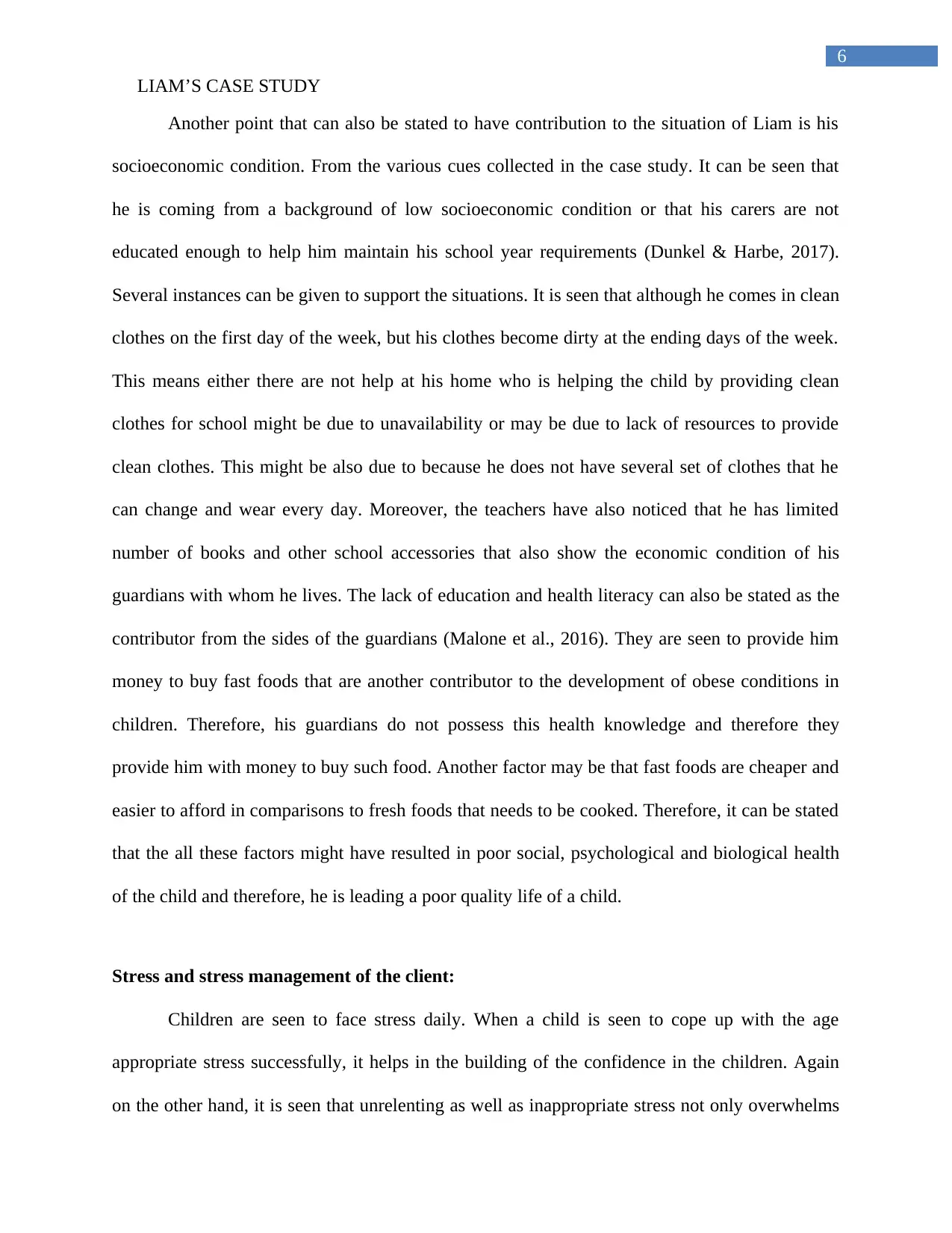
6
LIAM’S CASE STUDY
Another point that can also be stated to have contribution to the situation of Liam is his
socioeconomic condition. From the various cues collected in the case study. It can be seen that
he is coming from a background of low socioeconomic condition or that his carers are not
educated enough to help him maintain his school year requirements (Dunkel & Harbe, 2017).
Several instances can be given to support the situations. It is seen that although he comes in clean
clothes on the first day of the week, but his clothes become dirty at the ending days of the week.
This means either there are not help at his home who is helping the child by providing clean
clothes for school might be due to unavailability or may be due to lack of resources to provide
clean clothes. This might be also due to because he does not have several set of clothes that he
can change and wear every day. Moreover, the teachers have also noticed that he has limited
number of books and other school accessories that also show the economic condition of his
guardians with whom he lives. The lack of education and health literacy can also be stated as the
contributor from the sides of the guardians (Malone et al., 2016). They are seen to provide him
money to buy fast foods that are another contributor to the development of obese conditions in
children. Therefore, his guardians do not possess this health knowledge and therefore they
provide him with money to buy such food. Another factor may be that fast foods are cheaper and
easier to afford in comparisons to fresh foods that needs to be cooked. Therefore, it can be stated
that the all these factors might have resulted in poor social, psychological and biological health
of the child and therefore, he is leading a poor quality life of a child.
Stress and stress management of the client:
Children are seen to face stress daily. When a child is seen to cope up with the age
appropriate stress successfully, it helps in the building of the confidence in the children. Again
on the other hand, it is seen that unrelenting as well as inappropriate stress not only overwhelms
LIAM’S CASE STUDY
Another point that can also be stated to have contribution to the situation of Liam is his
socioeconomic condition. From the various cues collected in the case study. It can be seen that
he is coming from a background of low socioeconomic condition or that his carers are not
educated enough to help him maintain his school year requirements (Dunkel & Harbe, 2017).
Several instances can be given to support the situations. It is seen that although he comes in clean
clothes on the first day of the week, but his clothes become dirty at the ending days of the week.
This means either there are not help at his home who is helping the child by providing clean
clothes for school might be due to unavailability or may be due to lack of resources to provide
clean clothes. This might be also due to because he does not have several set of clothes that he
can change and wear every day. Moreover, the teachers have also noticed that he has limited
number of books and other school accessories that also show the economic condition of his
guardians with whom he lives. The lack of education and health literacy can also be stated as the
contributor from the sides of the guardians (Malone et al., 2016). They are seen to provide him
money to buy fast foods that are another contributor to the development of obese conditions in
children. Therefore, his guardians do not possess this health knowledge and therefore they
provide him with money to buy such food. Another factor may be that fast foods are cheaper and
easier to afford in comparisons to fresh foods that needs to be cooked. Therefore, it can be stated
that the all these factors might have resulted in poor social, psychological and biological health
of the child and therefore, he is leading a poor quality life of a child.
Stress and stress management of the client:
Children are seen to face stress daily. When a child is seen to cope up with the age
appropriate stress successfully, it helps in the building of the confidence in the children. Again
on the other hand, it is seen that unrelenting as well as inappropriate stress not only overwhelms
Paraphrase This Document
Need a fresh take? Get an instant paraphrase of this document with our AI Paraphraser
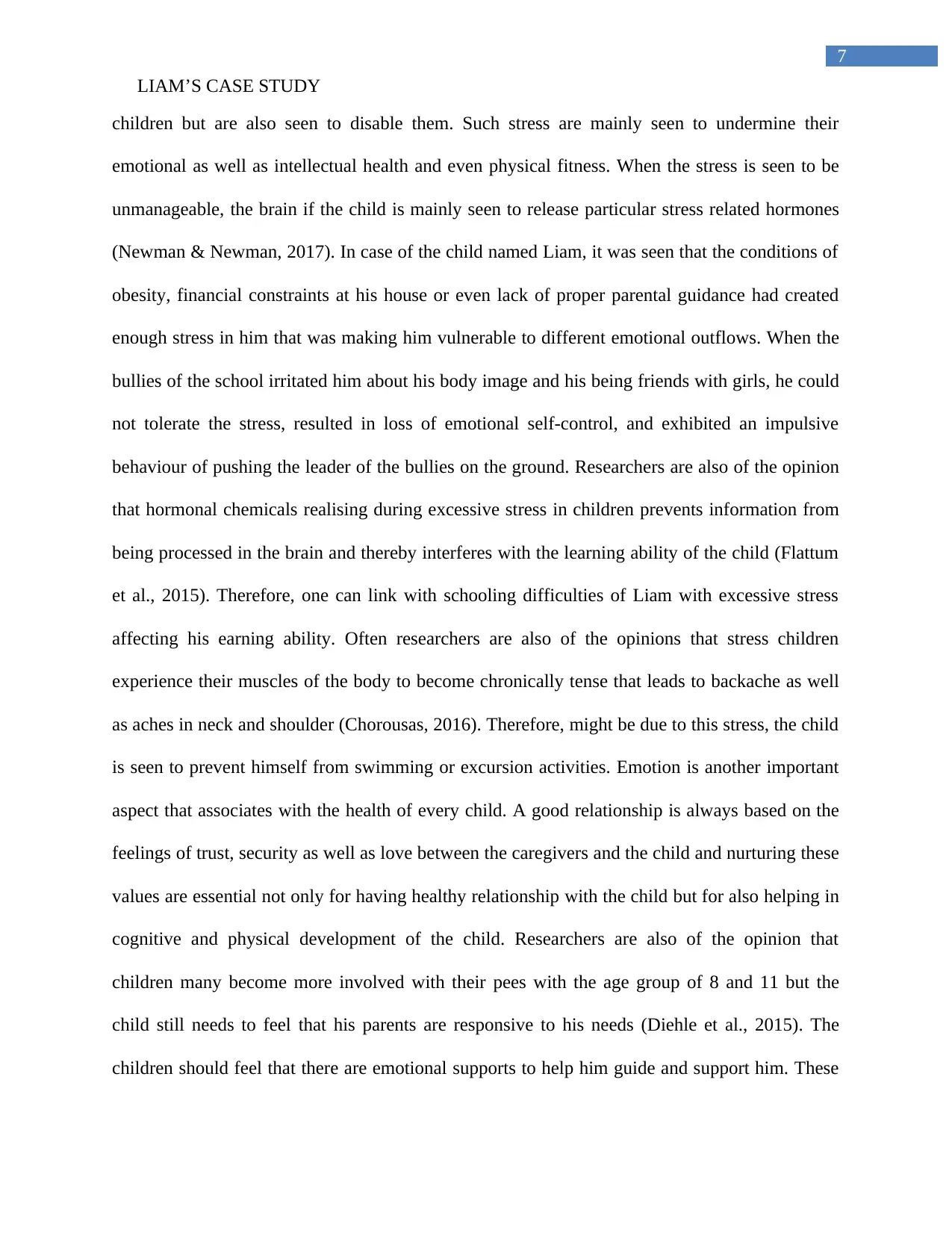
7
LIAM’S CASE STUDY
children but are also seen to disable them. Such stress are mainly seen to undermine their
emotional as well as intellectual health and even physical fitness. When the stress is seen to be
unmanageable, the brain if the child is mainly seen to release particular stress related hormones
(Newman & Newman, 2017). In case of the child named Liam, it was seen that the conditions of
obesity, financial constraints at his house or even lack of proper parental guidance had created
enough stress in him that was making him vulnerable to different emotional outflows. When the
bullies of the school irritated him about his body image and his being friends with girls, he could
not tolerate the stress, resulted in loss of emotional self-control, and exhibited an impulsive
behaviour of pushing the leader of the bullies on the ground. Researchers are also of the opinion
that hormonal chemicals realising during excessive stress in children prevents information from
being processed in the brain and thereby interferes with the learning ability of the child (Flattum
et al., 2015). Therefore, one can link with schooling difficulties of Liam with excessive stress
affecting his earning ability. Often researchers are also of the opinions that stress children
experience their muscles of the body to become chronically tense that leads to backache as well
as aches in neck and shoulder (Chorousas, 2016). Therefore, might be due to this stress, the child
is seen to prevent himself from swimming or excursion activities. Emotion is another important
aspect that associates with the health of every child. A good relationship is always based on the
feelings of trust, security as well as love between the caregivers and the child and nurturing these
values are essential not only for having healthy relationship with the child but for also helping in
cognitive and physical development of the child. Researchers are also of the opinion that
children many become more involved with their pees with the age group of 8 and 11 but the
child still needs to feel that his parents are responsive to his needs (Diehle et al., 2015). The
children should feel that there are emotional supports to help him guide and support him. These
LIAM’S CASE STUDY
children but are also seen to disable them. Such stress are mainly seen to undermine their
emotional as well as intellectual health and even physical fitness. When the stress is seen to be
unmanageable, the brain if the child is mainly seen to release particular stress related hormones
(Newman & Newman, 2017). In case of the child named Liam, it was seen that the conditions of
obesity, financial constraints at his house or even lack of proper parental guidance had created
enough stress in him that was making him vulnerable to different emotional outflows. When the
bullies of the school irritated him about his body image and his being friends with girls, he could
not tolerate the stress, resulted in loss of emotional self-control, and exhibited an impulsive
behaviour of pushing the leader of the bullies on the ground. Researchers are also of the opinion
that hormonal chemicals realising during excessive stress in children prevents information from
being processed in the brain and thereby interferes with the learning ability of the child (Flattum
et al., 2015). Therefore, one can link with schooling difficulties of Liam with excessive stress
affecting his earning ability. Often researchers are also of the opinions that stress children
experience their muscles of the body to become chronically tense that leads to backache as well
as aches in neck and shoulder (Chorousas, 2016). Therefore, might be due to this stress, the child
is seen to prevent himself from swimming or excursion activities. Emotion is another important
aspect that associates with the health of every child. A good relationship is always based on the
feelings of trust, security as well as love between the caregivers and the child and nurturing these
values are essential not only for having healthy relationship with the child but for also helping in
cognitive and physical development of the child. Researchers are also of the opinion that
children many become more involved with their pees with the age group of 8 and 11 but the
child still needs to feel that his parents are responsive to his needs (Diehle et al., 2015). The
children should feel that there are emotional supports to help him guide and support him. These
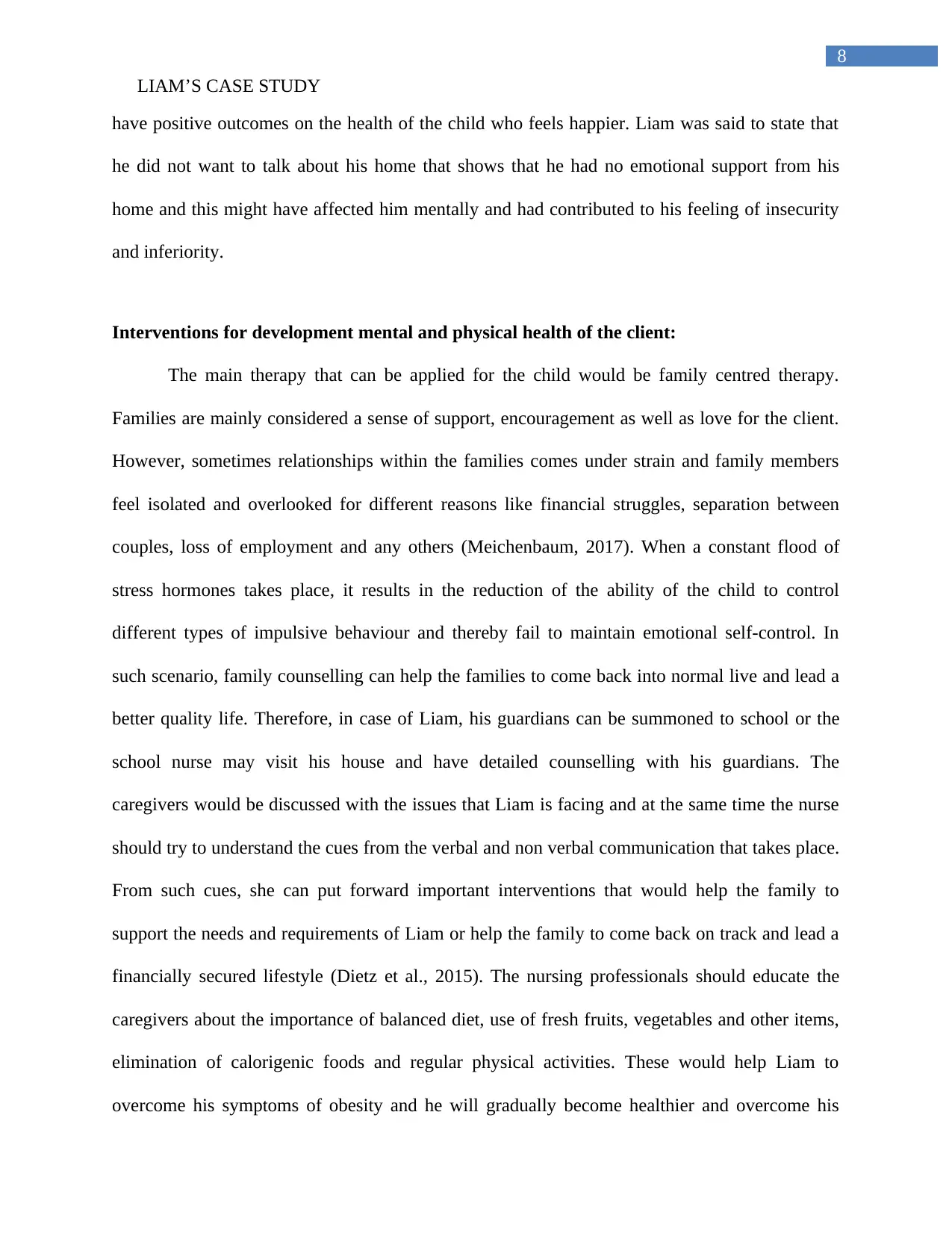
8
LIAM’S CASE STUDY
have positive outcomes on the health of the child who feels happier. Liam was said to state that
he did not want to talk about his home that shows that he had no emotional support from his
home and this might have affected him mentally and had contributed to his feeling of insecurity
and inferiority.
Interventions for development mental and physical health of the client:
The main therapy that can be applied for the child would be family centred therapy.
Families are mainly considered a sense of support, encouragement as well as love for the client.
However, sometimes relationships within the families comes under strain and family members
feel isolated and overlooked for different reasons like financial struggles, separation between
couples, loss of employment and any others (Meichenbaum, 2017). When a constant flood of
stress hormones takes place, it results in the reduction of the ability of the child to control
different types of impulsive behaviour and thereby fail to maintain emotional self-control. In
such scenario, family counselling can help the families to come back into normal live and lead a
better quality life. Therefore, in case of Liam, his guardians can be summoned to school or the
school nurse may visit his house and have detailed counselling with his guardians. The
caregivers would be discussed with the issues that Liam is facing and at the same time the nurse
should try to understand the cues from the verbal and non verbal communication that takes place.
From such cues, she can put forward important interventions that would help the family to
support the needs and requirements of Liam or help the family to come back on track and lead a
financially secured lifestyle (Dietz et al., 2015). The nursing professionals should educate the
caregivers about the importance of balanced diet, use of fresh fruits, vegetables and other items,
elimination of calorigenic foods and regular physical activities. These would help Liam to
overcome his symptoms of obesity and he will gradually become healthier and overcome his
LIAM’S CASE STUDY
have positive outcomes on the health of the child who feels happier. Liam was said to state that
he did not want to talk about his home that shows that he had no emotional support from his
home and this might have affected him mentally and had contributed to his feeling of insecurity
and inferiority.
Interventions for development mental and physical health of the client:
The main therapy that can be applied for the child would be family centred therapy.
Families are mainly considered a sense of support, encouragement as well as love for the client.
However, sometimes relationships within the families comes under strain and family members
feel isolated and overlooked for different reasons like financial struggles, separation between
couples, loss of employment and any others (Meichenbaum, 2017). When a constant flood of
stress hormones takes place, it results in the reduction of the ability of the child to control
different types of impulsive behaviour and thereby fail to maintain emotional self-control. In
such scenario, family counselling can help the families to come back into normal live and lead a
better quality life. Therefore, in case of Liam, his guardians can be summoned to school or the
school nurse may visit his house and have detailed counselling with his guardians. The
caregivers would be discussed with the issues that Liam is facing and at the same time the nurse
should try to understand the cues from the verbal and non verbal communication that takes place.
From such cues, she can put forward important interventions that would help the family to
support the needs and requirements of Liam or help the family to come back on track and lead a
financially secured lifestyle (Dietz et al., 2015). The nursing professionals should educate the
caregivers about the importance of balanced diet, use of fresh fruits, vegetables and other items,
elimination of calorigenic foods and regular physical activities. These would help Liam to
overcome his symptoms of obesity and he will gradually become healthier and overcome his
⊘ This is a preview!⊘
Do you want full access?
Subscribe today to unlock all pages.

Trusted by 1+ million students worldwide
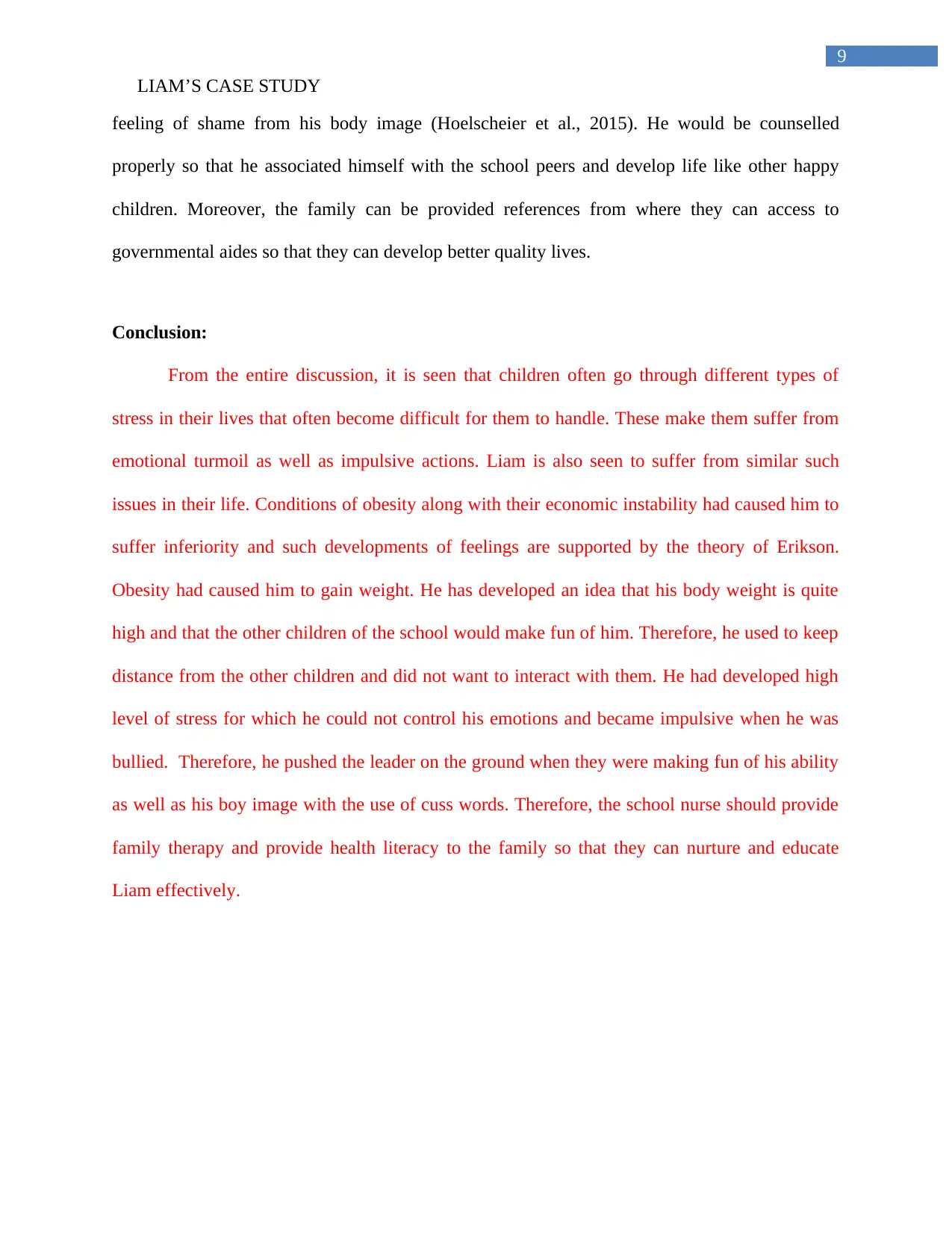
9
LIAM’S CASE STUDY
feeling of shame from his body image (Hoelscheier et al., 2015). He would be counselled
properly so that he associated himself with the school peers and develop life like other happy
children. Moreover, the family can be provided references from where they can access to
governmental aides so that they can develop better quality lives.
Conclusion:
From the entire discussion, it is seen that children often go through different types of
stress in their lives that often become difficult for them to handle. These make them suffer from
emotional turmoil as well as impulsive actions. Liam is also seen to suffer from similar such
issues in their life. Conditions of obesity along with their economic instability had caused him to
suffer inferiority and such developments of feelings are supported by the theory of Erikson.
Obesity had caused him to gain weight. He has developed an idea that his body weight is quite
high and that the other children of the school would make fun of him. Therefore, he used to keep
distance from the other children and did not want to interact with them. He had developed high
level of stress for which he could not control his emotions and became impulsive when he was
bullied. Therefore, he pushed the leader on the ground when they were making fun of his ability
as well as his boy image with the use of cuss words. Therefore, the school nurse should provide
family therapy and provide health literacy to the family so that they can nurture and educate
Liam effectively.
LIAM’S CASE STUDY
feeling of shame from his body image (Hoelscheier et al., 2015). He would be counselled
properly so that he associated himself with the school peers and develop life like other happy
children. Moreover, the family can be provided references from where they can access to
governmental aides so that they can develop better quality lives.
Conclusion:
From the entire discussion, it is seen that children often go through different types of
stress in their lives that often become difficult for them to handle. These make them suffer from
emotional turmoil as well as impulsive actions. Liam is also seen to suffer from similar such
issues in their life. Conditions of obesity along with their economic instability had caused him to
suffer inferiority and such developments of feelings are supported by the theory of Erikson.
Obesity had caused him to gain weight. He has developed an idea that his body weight is quite
high and that the other children of the school would make fun of him. Therefore, he used to keep
distance from the other children and did not want to interact with them. He had developed high
level of stress for which he could not control his emotions and became impulsive when he was
bullied. Therefore, he pushed the leader on the ground when they were making fun of his ability
as well as his boy image with the use of cuss words. Therefore, the school nurse should provide
family therapy and provide health literacy to the family so that they can nurture and educate
Liam effectively.
Paraphrase This Document
Need a fresh take? Get an instant paraphrase of this document with our AI Paraphraser
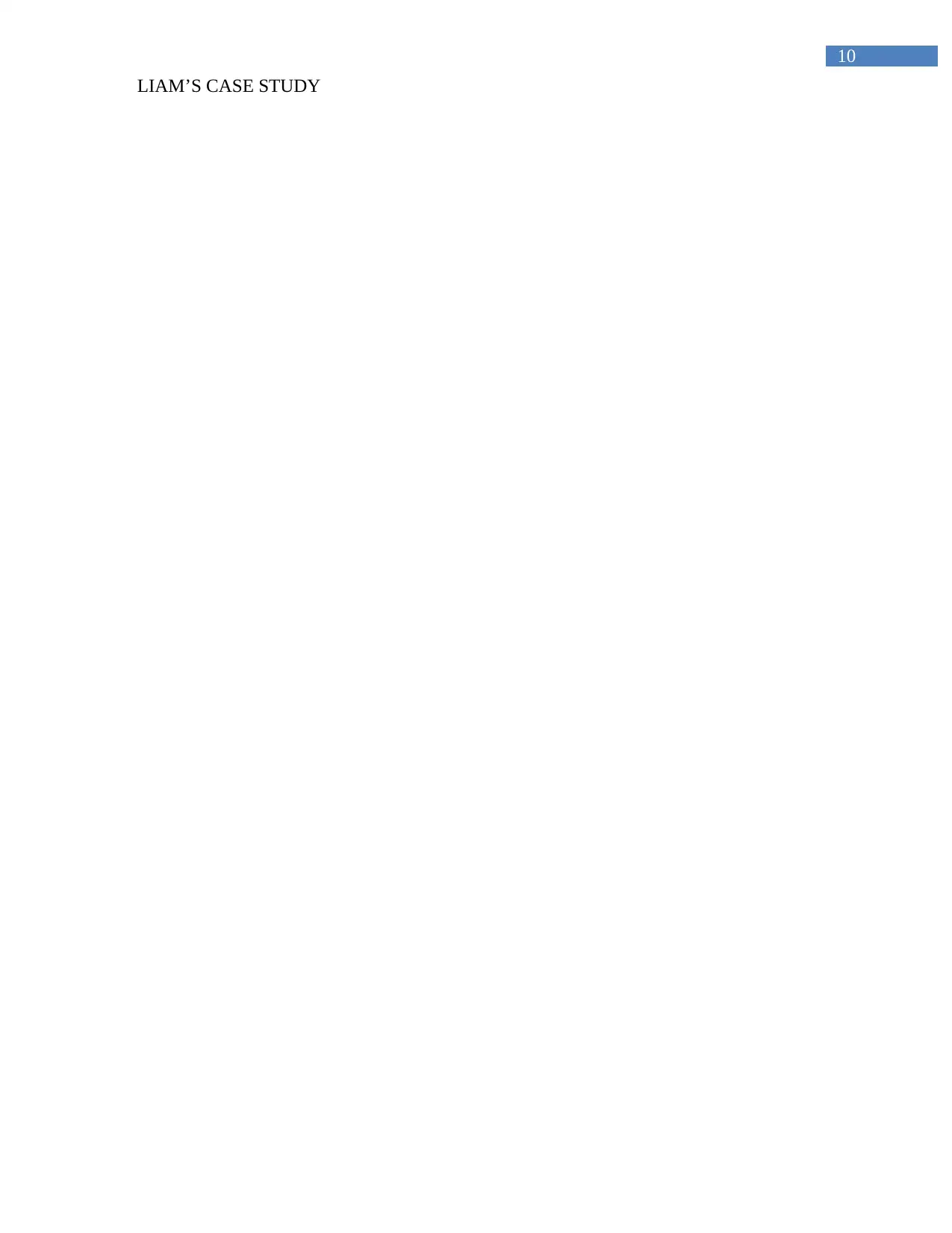
10
LIAM’S CASE STUDY
LIAM’S CASE STUDY
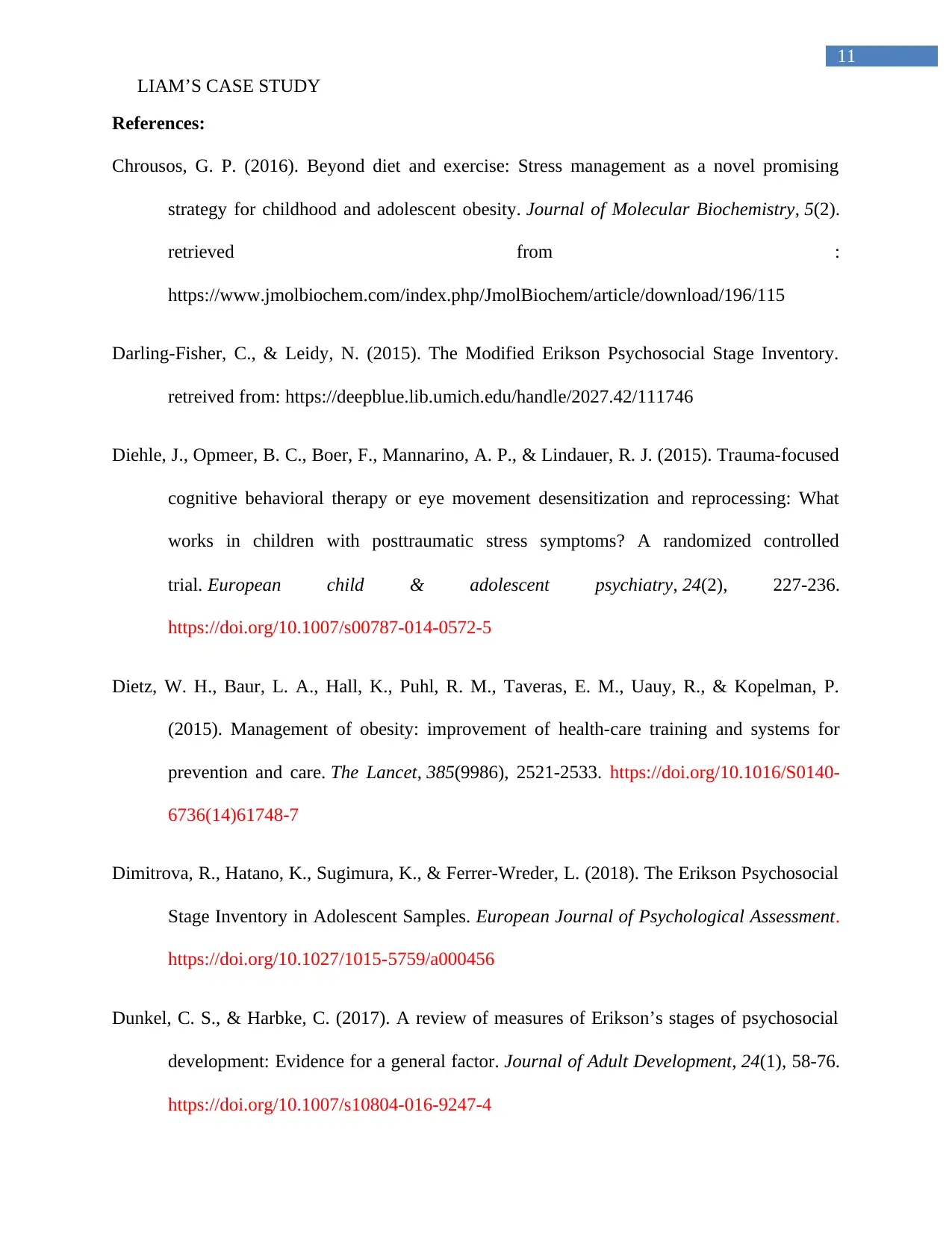
11
LIAM’S CASE STUDY
References:
Chrousos, G. P. (2016). Beyond diet and exercise: Stress management as a novel promising
strategy for childhood and adolescent obesity. Journal of Molecular Biochemistry, 5(2).
retrieved from :
https://www.jmolbiochem.com/index.php/JmolBiochem/article/download/196/115
Darling-Fisher, C., & Leidy, N. (2015). The Modified Erikson Psychosocial Stage Inventory.
retreived from: https://deepblue.lib.umich.edu/handle/2027.42/111746
Diehle, J., Opmeer, B. C., Boer, F., Mannarino, A. P., & Lindauer, R. J. (2015). Trauma-focused
cognitive behavioral therapy or eye movement desensitization and reprocessing: What
works in children with posttraumatic stress symptoms? A randomized controlled
trial. European child & adolescent psychiatry, 24(2), 227-236.
https://doi.org/10.1007/s00787-014-0572-5
Dietz, W. H., Baur, L. A., Hall, K., Puhl, R. M., Taveras, E. M., Uauy, R., & Kopelman, P.
(2015). Management of obesity: improvement of health-care training and systems for
prevention and care. The Lancet, 385(9986), 2521-2533. https://doi.org/10.1016/S0140-
6736(14)61748-7
Dimitrova, R., Hatano, K., Sugimura, K., & Ferrer-Wreder, L. (2018). The Erikson Psychosocial
Stage Inventory in Adolescent Samples. European Journal of Psychological Assessment.
https://doi.org/10.1027/1015-5759/a000456
Dunkel, C. S., & Harbke, C. (2017). A review of measures of Erikson’s stages of psychosocial
development: Evidence for a general factor. Journal of Adult Development, 24(1), 58-76.
https://doi.org/10.1007/s10804-016-9247-4
LIAM’S CASE STUDY
References:
Chrousos, G. P. (2016). Beyond diet and exercise: Stress management as a novel promising
strategy for childhood and adolescent obesity. Journal of Molecular Biochemistry, 5(2).
retrieved from :
https://www.jmolbiochem.com/index.php/JmolBiochem/article/download/196/115
Darling-Fisher, C., & Leidy, N. (2015). The Modified Erikson Psychosocial Stage Inventory.
retreived from: https://deepblue.lib.umich.edu/handle/2027.42/111746
Diehle, J., Opmeer, B. C., Boer, F., Mannarino, A. P., & Lindauer, R. J. (2015). Trauma-focused
cognitive behavioral therapy or eye movement desensitization and reprocessing: What
works in children with posttraumatic stress symptoms? A randomized controlled
trial. European child & adolescent psychiatry, 24(2), 227-236.
https://doi.org/10.1007/s00787-014-0572-5
Dietz, W. H., Baur, L. A., Hall, K., Puhl, R. M., Taveras, E. M., Uauy, R., & Kopelman, P.
(2015). Management of obesity: improvement of health-care training and systems for
prevention and care. The Lancet, 385(9986), 2521-2533. https://doi.org/10.1016/S0140-
6736(14)61748-7
Dimitrova, R., Hatano, K., Sugimura, K., & Ferrer-Wreder, L. (2018). The Erikson Psychosocial
Stage Inventory in Adolescent Samples. European Journal of Psychological Assessment.
https://doi.org/10.1027/1015-5759/a000456
Dunkel, C. S., & Harbke, C. (2017). A review of measures of Erikson’s stages of psychosocial
development: Evidence for a general factor. Journal of Adult Development, 24(1), 58-76.
https://doi.org/10.1007/s10804-016-9247-4
⊘ This is a preview!⊘
Do you want full access?
Subscribe today to unlock all pages.

Trusted by 1+ million students worldwide
1 out of 15
Related Documents
Your All-in-One AI-Powered Toolkit for Academic Success.
+13062052269
info@desklib.com
Available 24*7 on WhatsApp / Email
![[object Object]](/_next/static/media/star-bottom.7253800d.svg)
Unlock your academic potential
Copyright © 2020–2025 A2Z Services. All Rights Reserved. Developed and managed by ZUCOL.





